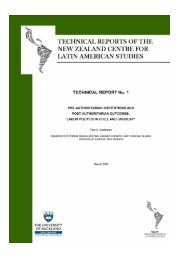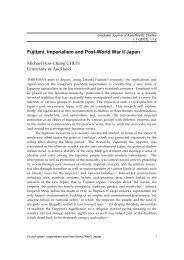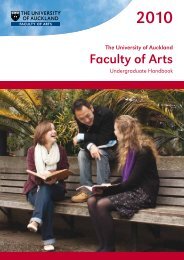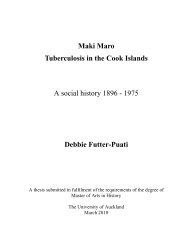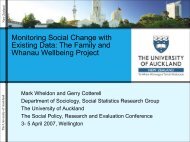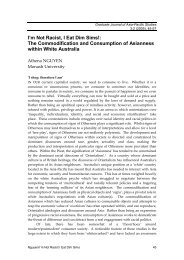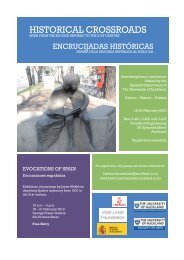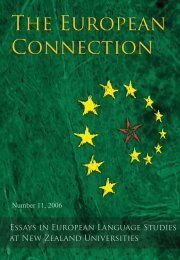You also want an ePaper? Increase the reach of your titles
YUMPU automatically turns print PDFs into web optimized ePapers that Google loves.
exchanges between Tama and his siblings foreground <strong>the</strong> principle <strong>of</strong> morehu or<br />
survival, in practical terms as well; <strong>the</strong>y have to survive his defection when he<br />
chooses not to honour <strong>the</strong> obligation to return and care for <strong>the</strong>m after <strong>the</strong>ir fa<strong>the</strong>r’s<br />
death. Huia and Tama have to survive not only an event, which has haunted <strong>the</strong>m<br />
for years, but its outcome:<br />
‘I watched Eric Amundsen, repelled by him and angered at myself for bringing Mum<br />
to see him. . . .<br />
“Eric keeps seeing a huge glowing river”, Dr Stephens explained. “It’s a river that<br />
comes out <strong>of</strong> nowhere and recedes into some darkness way beyond <strong>the</strong> room he is in,<br />
In our sessions with him, Eric has been able to tell us about <strong>the</strong> river. It’s <strong>the</strong> most<br />
beautiful thing he has ever seen. It’s threaded with <strong>man</strong>y colours, like a glorious<br />
rainbow. There are voices in <strong>the</strong> river and <strong>the</strong>y are calling him”. . . . .<br />
“It isn’t a river”, I said’. 23<br />
The most powerful moment in ‘The Return, 2005’ describes <strong>the</strong> ascent onto <strong>the</strong> marae<br />
<strong>of</strong> <strong>the</strong> group from <strong>the</strong> psychiatric facility:<br />
‘I watched Eric Amundsen as he approached. He was making swimming movements<br />
with his arms, his eyes were glowing with gladness. What did he see as he swam<br />
towards <strong>the</strong> river that wasn’t a river . . . .<br />
For two years he had been dreaming <strong>of</strong> a river and had tried to join its stream, but it<br />
wasn’t a river. Spiralling out <strong>of</strong> nowhere was a <strong>rope</strong> stretching from <strong>the</strong> beginning to<br />
<strong>the</strong> end <strong>of</strong> time . . . .<br />
This time as he swam towards <strong>the</strong> river, <strong>the</strong> <strong>rope</strong> recognised him’. 24<br />
Permitted to embrace his Māori ancestry this <strong>man</strong> may now benefit from its<br />
distinctive knowledges and practices. There are implications here too for <strong>the</strong> future<br />
in <strong>the</strong> idea <strong>of</strong> an adoptive Pākehā mo<strong>the</strong>r seeking a Māori healing for her son.<br />
<strong>the</strong> <strong>rope</strong> <strong>of</strong> <strong>man</strong> successfully communicates <strong>the</strong> need to realise a sense <strong>of</strong><br />
belonging and place, one which allows us to appreciate our cultural diversity.<br />
Occasionally pretentious, <strong>the</strong> novel supports a national identity with expatriates torn<br />
between staying and returning who address <strong>the</strong> narrator as ‘sir’. 25 Its characters are<br />
credible; even a narrator with a lop‐sided grin disconcertingly close to <strong>the</strong> writer’s<br />
own. Its catalogue <strong>of</strong> major media events over <strong>the</strong> last thirty years and <strong>the</strong> level <strong>of</strong><br />
research it has required is especially evident in <strong>the</strong> international broadcast <strong>of</strong> <strong>the</strong><br />
finale. This emphasis embraces a global community and sustains <strong>the</strong> notion <strong>of</strong> our<br />
common hu<strong>man</strong>ity.<br />
The novel concludes with <strong>the</strong> words ‘We bow only to <strong>the</strong> highest mountain’. 26<br />
This final statement in English is a commentary on <strong>the</strong> calibre <strong>of</strong> Māori and New<br />
Zealanders. Only one point back on <strong>the</strong> curve <strong>of</strong> <strong>the</strong> spiral and <strong>the</strong> pepeha 27 is in<br />
Māori: ‘Me te tuohu koe, me tuohu ki te maunga teitei’. 28 This tribal saying is not a<br />
measure <strong>of</strong> defeat, it attests to <strong>the</strong> values and <strong>the</strong> <strong>man</strong>a 29 <strong>of</strong> <strong>the</strong> Māori people.<br />
Jon BATTISTA<br />
University <strong>of</strong> Auckland<br />
120<br />
www.arts.auckland.ac.nz/gjaps




